-- Published: Monday, 25 May 2015 | Print | Disqus

Source: www.stockcharts.com
I couldn’t help but be struck by an article about gold in the Economist in early May entitled “Buried” – The Economist, May 2, 2015. Okay, I know it is three weeks later and I am only now getting around to it. Delayed reaction one supposes and not always wanting to be writing about gold. But just as I thought about writing about it, I discovered that David Stockman, the former Director of the Office of Management and Budget in the Reagan administration beat me to it and wrote about the subject in an article on his Contra Corner (http://davidstockmanscontracorner.com/why-gold-is-looking-better-the-economist-pronounced-it-buried/).
Ok none of that stops others or me from commenting on the same topic. David Stockman writes from an interesting perspective given his years on the inside of Washington and the financial industry. Mr. Stockman was also a Republican Congressman and after he left government he joined investment bank Solomon Brothers and later private equity firm Blackstone Group.
Since Stockman left Blackstone in 1999, he has been involved in a number of endeavours including starting his own private equity firm and later he was CEO of a Detroit manufacturer of auto parts that went bankrupt. The latter firm filed for Chapter 11 bankruptcy in 2005 and Mr. Stockman was charged by Federal prosecutors with fraud and by the SEC for his role as CEO of the company. Mr. Stockman was eventually cleared but not after it cost him a great deal of money and reputation. He launched the Contra Corner in 2014 and since then his plus articles from others have largely taken a contra stance against the actions of the US Government and the global financial system.
The Economist article effectively declared that gold was dead and buried. They even quoted well known commentator Harry Dent whose advertisements calling for $700 gold have been seen by many. Mr. Dent is quoted as asking, “Where is the damn hyperinflation” something many believe is necessary for gold prices to rise to the heights of nirvana. Naturally, the statement ignores the move from $680 to $1,923 seen from 2008 to 2011 out of the depths of the financial crash of 2008 against a backdrop of negligible inflation. As if gold needs hyperinflation to rise. That forgets as well that gold was revalued upwards by 70% in the depths of the Great Depression and gold stocks rose some 400% during the Great Depression while the Dow Jones Industrials (DJI) was collapsing 89%. Mr. Dent seems to be living in the inflationary 1970’s believing it was huge inflation that drove gold prices to $875 by 1980.
Since the gold standard ended in August 1971 and the world moved into its latest experiment with fiat currency, gold has responded more to a lack of confidence in government and the financial system on being able to solve the financial problems of day. During the 1970’s while gold was rising the US$ was falling. From a peak in July 1977 to a low in early January 1980 the US$ Index fell 26%. All of this came against the backdrop of rising inflation, bankruptcies and the deepest recession since the Great Depression.
Gold rose during the same period 519%. Confidence in the financial system and governments’ ability to solve the financial problems wavered. It took former Fed Chairman Paul Volker raising short-term interest rates to 20% (actually the Fed discount rate rose only to 13% but other short term rates rose considerably higher) that helped restore confidence and send the US$ higher and it signaled the end of the 1970’s gold bull. The steep interest rate rise sparked another severe recession in the early 1980’s.
In many respects, the move in gold from the depths of the 2008 financial crisis was similar. It was a growing loss of confidence in the financial system and the governments’ ability to solve it. The financial system was facing bankruptcies, bailouts and the most massive injection of liquidity into the system ever seen (QE1, QE2, QE3). The rise from 2001when gold was trading closer to $250 to a high just over $1,000 in March 2008 was coincidental with another long decline in the value of the US$. In July 2011 the US$ hit its lowest point and coincident with that in September 2011 gold topped. The US$ and gold have a long history of moving inversely to each other. It is considered significant when gold holds its own or even rises when the US$ is rising as well.
Many say that gold is money. But money or the means of exchange for goods and services and payment of debts can come in many forms. At one time money was an established commodity such as gold, silver and copper. Today most money systems are fiat meaning that the money itself has no intrinsic value but has been declared by the government as legal tender. If governments were to abolish paper money as legal tender and move to a cashless society it would mean that money was now just a blip on a screen. Today in the Euro zone there are attempts being made to move to a cashless society.
As to gold being buried well historically, that actually was not unusual. That is meant in the literal sense. It has not been unusual to find hordes of ancient gold, silver, copper, and bronze coins horded usually in large urns. Hordes are still being found today. Many of these ancient coins still exist today and are now in the hands of collectors and museums. All ancient coins still have intrinsic value. Many have considerable numismatic value. That is particularly true of gold and silver coins. Many of the smaller denomination copper coins that were used primarily by the masses have actually just disappeared. Silver coins were the standard of the day. In Ancient Greece, it was the Stater while in Ancient Rome it was the denarius. Gold coins throughout ancient times were the coins of the highest value.
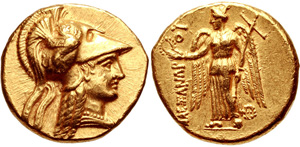
Kings of Macedon, Alexander III ‘The Great’
336-323 BC AV Stater 8.57 gr.
Sold for $8,750
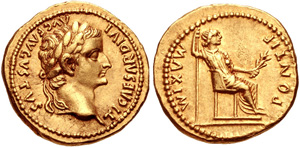
Tiberius, AD 14-37, AV Aureus 7.76 gr.
Sold for $17,500
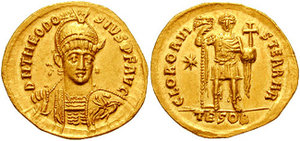
Theodosius II, 408-450 AD, AV Solidus 4.3 gr.
Sold for $795

Justinian II, 1st reign, 685-695 AV Solidus 4.44 gr.
Earliest Numismatic Portrait of Christ
Sold for $7,750
Source: All images www.cngcoins.com.
Intrinsically the above four pieces are worth (@ $1,200/troy ounce gold) $335, $330, $170 and $175 respectively. Despite the centuries, they all have held intrinsic value while the price noted above is the numismatic price they sold for. The odds of a Cdn $2 or toonie being worth anything intrinsically a 1,000 years from now is most likely zero which is about what it is worth today (sorry to say a toonie is not worth $2 intrinsically). However, pre 1967 Cdn silver dollars still have intrinsic value no matter what the condition.
So I confess I was somewhat confused by the Economist stating that gold prices were buried. Despite falling about 37% from the 2011 high, gold prices are still up 370% from the April 2001 low. By contrast the DJI is up only 70%, the S&P 500 is also up only 70% and the TSX Composite has gained 90%. The gold stocks? Well not as good. The TSX Gold Index is only up 42% in the same period. Silver has gained almost 300%. That would seem to suggest gold and silver have not only held their value they have increased in value considerably since 2001 outperforming other assets particularly paper assets of the stock markets. If gold were buried as the Economist would seem to be suggesting one can imagine that it has badly underperformed when compared to stock market assets. That has not been the case although the most recent period from 2011 to present has seen gold and silver underperform vs. the stock market.
Can gold continue to rise once the current corrective period is over? As noted gold appears to trade inversely to the value of the US$. When stated in other currencies such as the Euro and the Cdn$ gold has performed rather admirably in 2015. Gold is up about 11% in Euro terms and up just under 7% in Cdn$ so far in 2015. In those currencies gold has outperformed gold priced in US$ and the stock markets.
Ultimately, gold prices rising sharply is a sign of a potential loss of confidence in government and its ability to solve the globes financial problems. It manifests itself in a rising US$ suggesting all is well. But when one thinks about it all is most likely not well. Global growth is anaemic at best with even China beginning to stumble. The western economies are threatening to slide back into recession at worse or just muddle along at best. All of this has happened despite three rounds of QE in the US, ongoing years of QE in Japan and now the latest experiment with QE in the Euro zone. Still unemployment remains high, inequality has increased, debt has grown by trillions of dollars since 2007 and the financial crisis, and, the Fed’s balance sheet grew from $800 billion to $4.5 trillion. The assets on the Fed’s books makes the Fed look more like a hedge fund rather than a central bank.
Six years after the worst financial crisis since the 1930’s, banks in the Euro zone are moving to negative interest rates an almost unheard of state of affairs. People are withdrawing their money to effectively put “under the mattress” as a result. Many banks globally remain undercapitalized and could still have the potential of loans at risk of default on their books. Sovereigns such as Greece and Ukraine are at risk of default although in the scheme of things they are not large. But the reverberations back on the banking system could be more than many expect as well as contagion to other countries (Italy, Spain and Portugal as an example). Couple this with growing global tensions in the Ukraine, the South China Sea and ever-ongoing tensions in the Mid-East and somewhere amongst all these issues there remains the potential for a black swan event that could trigger another global financial crisis on the scale of 2008 or larger.
Despite this background, complacency remains high. Market sentiment while off its highs remains high. Leverage in the stock markets remains at or near record levels. Many just do not believe that another financial crisis on the scale of 2008 could take place. After all the Fed and the central banks are expected to come to the rescue. But what if they can’t? Bail-ins have been put in place to replace bailouts. The western governments are tapped out when it comes to bailing out the “too big to fail” banks that make up most of the banking system. They have no further room to tap into the taxpayer in order to bailout the financial system if it should be threatened with collapse once again.
Yet with the addition of $57 trillion of new debt since 2007 and billions or more written for credit default swaps and other derivatives the risks of a market meltdown remains extremely high if a black swan event were to occur. The Fed’s stress index remains at or near record lows. Faith that the central banks and their policies could bail everyone out is at or near its highs.
Gold is the ultimate hedge against bad government and central banks. Yet despite a surge in investment demand in China and more recently Germany and parts of the Euro zone, gold is an under owned asset in North America. Over the past year central banks have remained net buyers of gold. Central bank buying has been led by Russia and China. The Economist article even takes a dig at Russian President Putin that investors would not take him on as their financial advisor. But a possible prime reason why North American’s have not demonstrated the same faith in gold as do Asians and Europeans is that they have not witnessed the kind of wealth destruction and even government confiscation that has taken place in the past in Europe and Asia. This coupled with an undue faith in central banks.
What, me worry?
Financial stress near record lows.
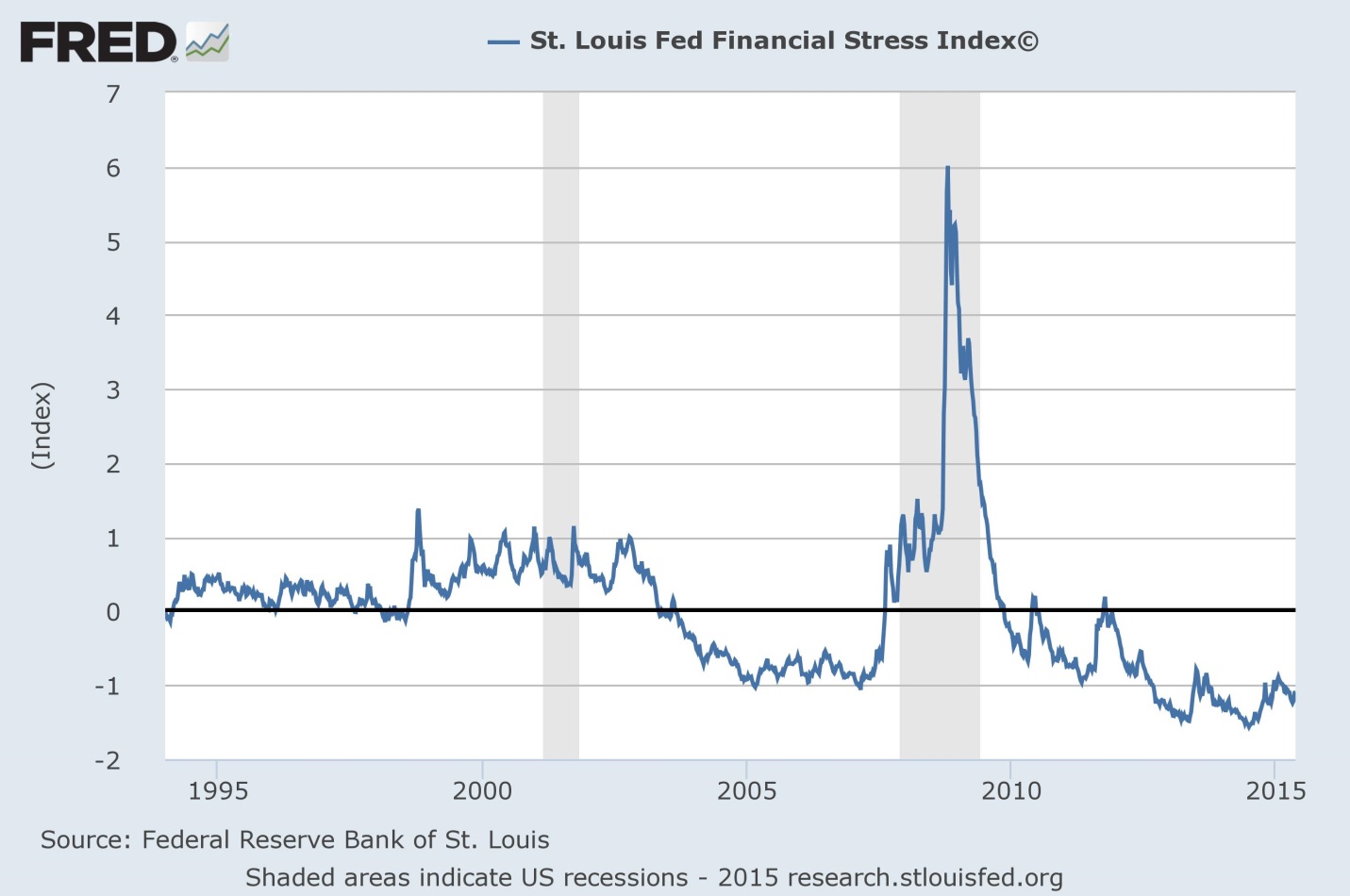
Source: www.stlouisfed.org
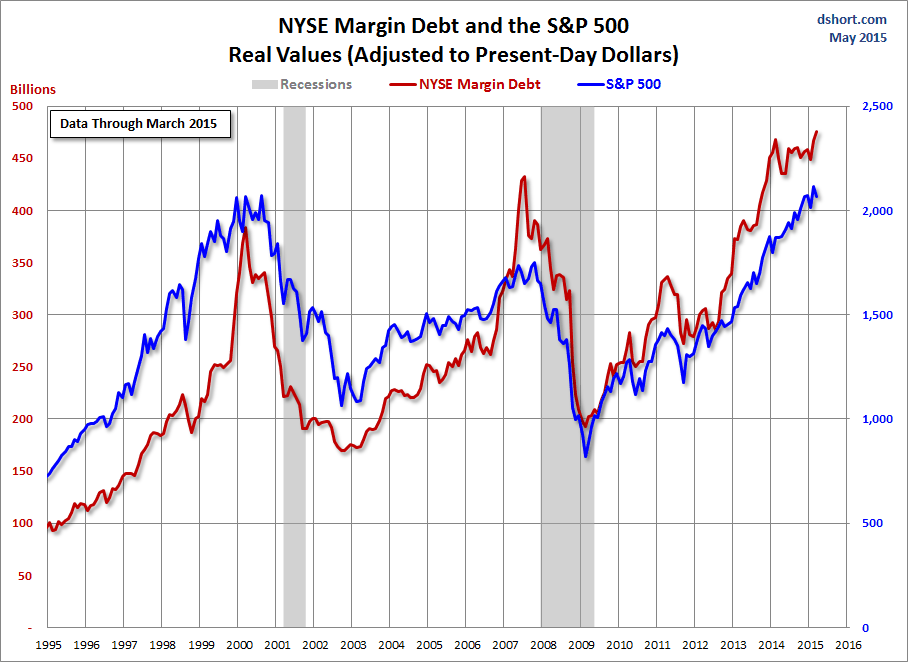
Margin debt is extremely high reflecting that complacency that exists in the stock markets.
Source: www.dshort.com
The monthly chart of gold shown at the outset remains ambiguous. It is acknowledged that the trendline up from the 2001 low is enticing to test. That line is currently near $850 and the high of 1980. There appears to be support down to $1,000 and maybe that could hold a drop in the gold price. Volume has one can see has fallen sharply throughout this corrective period. If the stock market were to fall, the price of gold could fall with it as it did in 2008. But recall gold only lost 33% vs. a loss of 55% for most of the stock markets back in 2008. The gold stocks did not fare as well losing upwards of 70%. When the turnaround came, gold led the way rising about 180% from 2008 to 2011.
Gold buried? No, I suspect it is just resting awaiting the next financial crisis that could be getting closer. Besides, as David Stockman points out the Economist has proven in the past to be an excellent contrarian indicator. It might pay to own some physical bullion either in accounts or as coins.
david@davidchapman.com
dchapman@iagto.ca
www.davidchapman.com

